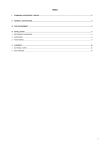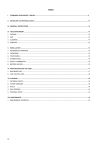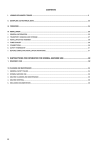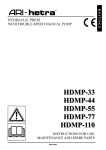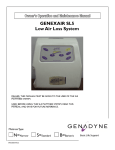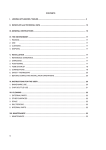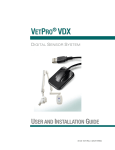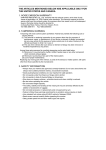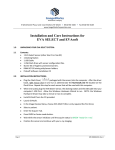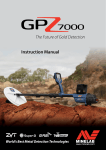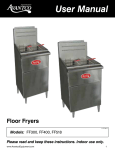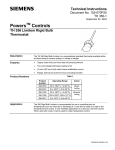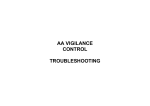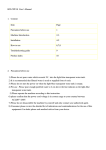Download User Manual - SharePoint
Transcript
CONTENTS I. INSTALLATION DIAGRAM / COMBINING APPLIANCES / TABLES ........................................................................................ 2 II. GENERAL INSTRUCTIONS ........................................................................................................................................................ 12 III. THE ENVIRONMENT .................................................................................................................................................................. 13 IV. INSTALLATION ............................................................................................................................................................................ 13 1. REFERENCE STANDARDS ........................................................................................................................................................ 13 2. UNPACKING ................................................................................................................................................................................ 13 3. POSITIONING .............................................................................................................................................................................. 14 V. CLEANING .................................................................................................................................................................................... 14 1. EXTERNAL PARTS ...................................................................................................................................................................... 14 2. SCALE .................................................................................................................................................................................... 14 3. IDLE PERIODS ............................................................................................................................................................................ 14 4. INTERNAL PARTS ....................................................................................................................................................................... 14 VI. MAINTENANCE ............................................................................................................................................................................ 14 1. MAINTENANCE SCHEDULE ...................................................................................................................................................... 14 11 II. GENERAL INSTRUCTIONS • Read the instruction handbook carefully before using the appliance. • Keep the instruction handbook for future reference. • RISK OF FIRE - Keep the area around the appliance free and clear of combustibles. Do not keep flammable materials in the vicinity of this appliance. • Inadequate ventilation causes asphyxia. Do not obstruct the ventilation system in the place where this appliance is installed. Do not obstruct the vents or ducts of this or other appliances. sos • Place emergency telephone numbers in a visible position. • Keep the instructions to be followed in case of smell of gas in the room in a visible position. This information is available from the gas company. • Installation and maintenance must only be carried out by qualified personnel authorised by the manufacturer. For assistance, contact an authorised service centre. Demand original replacements parts. • This appliance is designed for cooking food. It is intended for industrial use. Any use different from that indicated is improper. • This appliance is not intended for use by people (including children) with limited physical, sensory or mental abilities or without experience and knowledge of it, unless they are supervised or instructed in its use by a person responsible for their safety. • Personnel using the appliance must be trained. Do not leave the appliance unattended when in use. • Turn the appliance off in case of a fault or poor operation. • Do not use products (even if diluted) containing chlorine (sodium hypochlorite, hydrochloric or muriatic acid, etc.) to clean the appliance or the floor under it. Do not use metal implements (wire brushes or Scotch Brite type scouring pads) to clean the steel parts. Do not allow oil or grease to come into contact with plastic parts. • Do not allow dirt, fat, food or other residuals to form deposits on the appliance. • Do not clean the appliance with jets of water. L placed on the product indicates that should not to be regarded as domestic waste, but must be The symbol correctly disposed of in order to prevent any negative consequences for the environment and the health of people. For further information on the recycling of this product, contact the local dealer or agent, the after-sales service or the local body responsible for waste disposal. • • • • • • • Attention: do not use or store petrol or other flammable liquids, gases or materials in the vicinity of this or other appliances do not use sprays near this appliance while it is operating. this appliance is not suitable for marine environments Failure to observe the above can compromise appliance safety. Failure to observe the above invalidates the warranty. 12 III. THE ENVIRONMENT IV. INSTALLATION 1. PACKING The packing materials are environmentally friendly and can be stored without risk or burned in an appropriate waste incineration plant. Recyclable plastic components are marked with: • • PE Polyethylene: outer wrapping, instruction booklet bag, gas nozzle bag. • Carefully read the installation and maintenance procedures given in this instruction manual before installing the appliance. Installation, maintenance and conversion to another type of gas must only be carried out by qualified personnel authorised by the manufacturer. Failure to observe the correct installation, conversion and modification procedures can result in damage to the appliance, danger to people, and invalidates the Manufacturer’s warranty. Polypropylene: roof packing panels, straps. PP Polystyrene foam: corner protectors. 1. REFERENCE STANDARDS • PS • 2. USE Our appliances offer high performance and efficiency. To reduce electricity, water or gas consumption, do not use the appliance empty or in conditions that compromise optimum efficiency; the appliance must be used in a well-ventilated place, to avoid the creation of dangerous mixtures of unburnt gases in the room. When possible, preheat only before use. 3. CLEANING In order to reduce the emission of pollutants into the environment, clean the appliance (externally and when necessary internally) with products that are more than 90% biodegradable (for further information refer to section VII “CLEANING”). • • This appliance must comply with the applicable federal, state or local regulations. These installation procedures must be carried out by qualified personnel, otherwise the warranty will be invalidated. The NFPA (National Fire Protection Association) Inc states, in its latest 96 edition, that the local regulations are the competent authority regarding appliance installation requirements. Therefore, all connections (gas, electrical, water, discharges, etc.) must comply with all the local regulations. In the lack of local regulations, installation must be carried out in compliance with the National Fuel Gas Code, ANSI Z223.1/NFPA 54, or the Natural Gas and Propane Installation Code, CSAB 149.1, in particular: 1) the appliance must be disconnected from the gas supply during any operation on the system pressure exceeding 1/2 psi (35 mbar/3.5 kPa). 2) the appliance must be isolated from the gas supply during any operation on the system pressure below or equal to 1/2psi (35 mbar/3.5 kPa). 4. DISPOSAL Do not disperse in the environment. Our appliances are manufactured using more than 90% (in weight) recyclable metals (stainless steel, iron, aluminium, galvanised sheet, copper, etc.). Make the appliance unusable by removing the power cable and any compartment or cavity closing devices (when present) in order to avoid the risk of someone becoming trapped inside. 2. UNPACKING ATTENTION! Immediately check for any damage caused during transport. • The forwarder is responsible for the safety of the goods during transport and delivery. • Inspect the packing before and after unloading. • Make a complaint to the forwarder in case of visible or hidden damage, reporting any damage or shortages on the dispatch note upon delivery. • The driver must sign the dispatch note: The forwarder can reject the claim if the dispatch note is not signed (the forwarder can provide the necessary form). • Unpack, taking care not to damage the appliance. Wear protective gloves. • Carefully remove the protective film from metal surfaces and clean any traces of glue with a suitable solvent. • For hidden damage or shortages becoming apparent only after unpacking, request the forwarder for inspection of the goods within and not later than 15 days of delivery. • Keep all the documentation contained in the packing. 13 3. POSITIONING • Handle the appliance with care in order to avoid damage or danger to people. Use a pallet for handling and positioning. • The installation diagram provided in this instruction manual gives the appliance dimensions and the position of connections. Check that they are available and ready for making all the necessary connections. • The appliance can be installed separately or combined with other appliances of the same range. • Do not store or use flammable materials and liquids near the appliance. • Check and if necessary level the appliance after positioning. Incorrect levelling can cause appliance malfunctioning. 3.1. JOINING APPLIANCES (Fig. 1A- 1B-1C-1D) • Unscrew and remove feet “C” of the appliance to be fixed to the base (fig.1A). • Place the appliance on the compartment base, matching holes “F” on the crosspiece with the position of the previously removed feet (fig.1B). • Fix the appliance to the base using threaded pins “P” (accessory kit) (fig.1C). NOTE: To ensure joining of the two bases, use plate “U” as shown in figure 1D. V. CLEANING 1. EXTERNAL PARTS SATIN-FINISH STEEL SURFACES (daily) • Clean all steel surfaces: dirt is easily removed when it has just formed. • Remove grime, fat and other cooking residuals from steel surfaces when cool using soapy water, with or without detergent, and a cloth or sponge. Dry the surfaces thoroughly after cleaning. • In case of encrusted grime, fat or food residuals, go over with a cloth or sponge, wiping in the direction of the satin finish and rinsing often: rubbing in a circular motion combined with the particles of dirt on the cloth/sponge could spoil the steel’s satin finish. • Iron objects can spoil or damage the steel: spoiled surfaces become dirty more easily and are more subject to corrosion. • Restore the satin finish if necessary. SURFACES BLACKENED BY HEAT (when necessary) Exposure to high temperatures can cause dark marks to appear. These do not constitute damage and can be removed by following the instructions given in the previous section. 2. SCALE STEEL SURFACES (when necessary) Remove any scale (stains or marks) left by hard water on steel surfaces using suitable natural detergents (e.g. vinegar) or chemical (e.g. “STRIPAWAY” produced by ECOLAB). 3. IDLE PERIODS If the appliance is not going to be used for some time, take the following precautions: • Go over all stainless-steel surfaces vigorously with a cloth moistened with paraffin oil in order to spread a protective film. • Periodically air the premises. 4. INTERNAL PARTS (every 6 months) IMPORTANT! Operations to be carried out only by specialised technicians. • Remove any deposits of dirt inside the appliance. NOTE : In particular conditions (e.g. intensive appliance use, salty environment, etc.) the above cleaning should be more frequent. VI MAINTENANCE 1. MAINTENANCE SCHEDULE • 14 It is advisable to have the appliance inspected by an authorised person at least every 12 months. For this purpose, it is advisable to stipulate a servicing contract.





